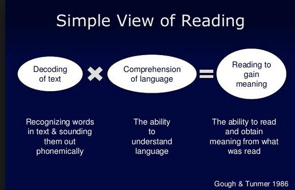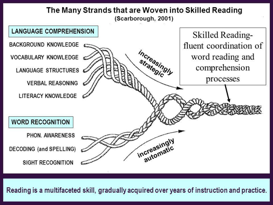Being a proficient reader has an impact on a student’s entire education. Teaching students to read is the work of educators. While some educators are well-equipped to take on such a significant task, others wish they were better prepared and supported to make an impact that could change a child’s life. IMSE makes it easy for teachers to access and understand the core principles of Structured Literacy and the Science of Reading (SoR) through their professional development trainings and programs. IMSE programs are delivered by experienced teachers, all with a master’s degree, who know how to ensure that teachers feel knowledgeable and supported in their ability to teach literacy.
Notably, over the past years, the Science of Reading has compiled information that holds important implications for empowering teachers with the knowledge to help students succeed in reading. In addition, intervention research estimates that the use of evidence-based prevention and intervention approaches in literacy, such as what IMSE offers, could decrease the number of below-level readers from 30% to 5%.
The Science of Reading: What it is
The Science of Reading is a comprehensive body of research that encompasses years of scientific knowledge, spans across many languages, and shares the contributions of experts from relevant disciplines such as education, special education, literacy, psychology, neurology, and more. The Science of Reading has evolved from a wide span of research designs, experimental methods, participants, and statistical analyses. This conclusive, empirically supported research provides us with the information we need to gain a deeper understanding of how we learn to read, what skills are involved, how they work together, and which parts of the brain are responsible for reading development. From this research, we can identify an evidence-based best practice approach for teaching foundational literacy skills called Structured Literacy.
David Kilpatrick stated, “We teach reading in different ways; they [students] learn to read proficiently in only one way.” The Science of Reading (SoR) has demystified any wonder of how we learn to read and offers evidence backed by science to confirm that there is one right way to teach reading. In addition to this, the SoR provides vital information to drive IMSE’s approach to instruction and to reach all learners.
The Science of Reading: What we know
- The SoR helps us to understand the cognitive processes that are essential for reading proficiency. It describes the development of reading skills for both typical and atypical readers.
- The SoR has debunked various methods used over the years to teach reading that were not based on scientific evidence.
- Most reading difficulties can be prevented in young, at-risk students. In other grades, studies have demonstrated the effectiveness of intensive phonemic awareness training, intensive phonic decoding training, and opportunities for repeated practice with reading controlled text. Intervention in these skills leads to efficient orthographic mapping and the highest degree of success.
- Teaching whole word memorization is limited, and learning phonics empowers students with an exponential effect.
- If a child memorizes ten words, then the child can read ten words. But, if the child can learn the sounds of ten letters, the child can read…
- 350 three-sound words
- 4,320 four-sound words
- 21,650 five-sound words
- If a child memorizes ten words, then the child can read ten words. But, if the child can learn the sounds of ten letters, the child can read…
- Reading development can be divided into three stages:
- Letters and sounds: Letter-sound knowledge is essential for both phonic decoding and sight-word learning.
- Phonic decoding: Early phonological awareness skills enable the development of letter-sound knowledge and should be targeted for direct instruction through first grade. Advanced phonological awareness skills should continue to be assessed and practiced through third grade to ensure that a solid orthographic lexicon is established.
- Orthographic mapping: Understanding orthographic mapping allows for teachers to support students who struggle to read. Orthographic mapping is the process that occurs when unfamiliar words become automatic sight words. The research on orthographic mapping explains how students develop this vast sight word bank for accurate and automatic word retrieval and also why students with reading problems struggle to develop this skill.
- Phonics and phonemic manipulation must be proficient to allow for students to build a sight word bank or orthographic lexicon. To support this, students need sufficient practice and review in decoding and encoding, knowledge and application of concept skills, and exposure to decodable text.
- Comprehension is the ultimate goal for reading. It is driven by two broad skill sets that are identified in the Simple View of Reading (SVoR).

- The Simple View of Reading (SVoR) is further detailed in Scarborough’s Reading Rope, which highlights the essential components of reading.

- Phonics is an important component in early, effective literacy-based instruction.
- Learning to spell is far more complex than just memorizing words. Encoding (spelling) is a developmental process that impacts fluency, writing, pronunciation, and vocabulary.
- Most teachers have received little knowledge about language structures that are used in reading, speaking, and writing. The SoR has compounded information but has yet to make it into the professional development of all teachers.
- Students with reading difficulties present on a continuum of severity and require highly skilled teachers who have the knowledge and expertise to provide intervention based on the SoR.
- The findings of the SoR translate into practices called Structured Literacy™. Structured Literacy is an approach to teach reading that is based on the Science of Reading.
Structured Literacy: How we teach
- Through Structured Literacy (SL), teachers implement methods that are appropriate for all students and particularly necessary for students with learning differences.
- Orton-Gillingham is an evidence-based SL approach that uses research from the SoR and incorporates recommended multi-sensory instructional techniques. SL supports instruction that is explicit, sequential, systematic, prescriptive, diagnostic, and cumulative.
- Instruction is assessment-driven. The diagnostic aspect of SL requires continued progress monitoring to measure outcomes and guide differentiation.
- Students are provided repeated opportunities with decodable text that have ample representations of the phonetic elements for code-emphasis.
- Through regular dictation of words and sentences containing the phonetic concept, students become skilled in spelling words within and outside of the text.
Structured Literacy: What we teach
- The SoR identifies five essential components that make up the Simple View of Reading. Structured Literacy incorporates all five:
- Phonemic Awareness
- Phonics
- Fluency
- Vocabulary
- Comprehension
- Students who have difficulty decoding need a focus on phoneme-grapheme and blending automaticity for both real and nonsense words. Teachers are skilled at differentiating instruction based on assessment results.
- Orthography helps students to understand why words are spelled the way they are spelled. Students learn to identify the overlapping features of words including word origin, phoneme-grapheme correspondence, position constraints, and patterns and conventions. This helps them to acquire the alphabetic principle.
- Phonemic awareness is emphasized as a necessary pre-reading skill and teachers recognize and target the sequence of skills to build phonological awareness from early to advanced skill levels.
- Regular words are taught according to phonetic patterns and irregular words are analyzed for their irregularities. When proficient readers encounter new words, they phonemically analyze the word for the regular grapheme-phoneme patterns and are able to identify the irregular element(s) with ease. Teaching weak readers to activate this process allows them to align the letters to the phonemes in their memory.
- Morphology is the study of meaningful units within words. Students are able to expand their vocabulary when they are directly exposed to the study of root words, prefixes, and suffixes.
The Science of Reading has proven that a Structured Literacy approach is a necessary foundation for reading success. As teachers, we make a commitment to continue our education to support the learning of every student. IMSE’s Orton-Gillingham training and programs make it possible for teachers to integrate evidence-based and research-based reading instruction and intervention strategies into Multi-Tiered Systems of Support (MTSS) to empower all students in every classroom.
Sign up for our LIVE virtual Orton-Gillingham training! We are now offering half-day, evening, and weekend options to best fit your schedule.
To learn more about the Science of Reading and Structured Literacy, check out the following great reads:
- Essentials of Assessing, Preventing, and Overcoming Reading Difficulties by David Kilpatrick
- Equipped for Reading Success by David Kilpatrick
- Reading in the Brain: The New Science of How We Read by Stanislas Dehaene
- Phonics from A to Z: A Practical Guide by Wiley Blevins
- Unlocking Literacy: Effective Decoding and Spelling Instruction by Marcia Henry
- Reader, Come Home: The Reading Brain in a Digital World by Maryanne Wolf
IMSE’s approach allows teachers to incorporate the five components essential to an effective reading program into their daily lessons: phonemic awareness, phonics, vocabulary, fluency, and comprehension.
The approach is based on the Orton-Gillingham methodology and focuses on explicit, direct instruction that is sequential, structured, and multi-sensory.
It is IMSE’s mission that all children must have the ability to read to fully realize their potential. We are committed to providing teachers with the knowledge and tools to deliver proven literacy education to students of all ages and abilities.
About The Author
 Dr. Kirstina Ordetx is a Level 4 Master Instructor with The Institute for Multi-Sensory Education (IMSE). She holds a doctorate in Counseling Psychology with a concentration in pediatric neurology. Dr. Ordetx is an educational specialist with over 25 years of clinical experience, research, and consultation. She is a certified Structured Literacy Dyslexia Interventionist through the Center for Effective Reading Instruction, a Certified Nutrition and Wellness Consultant, Executive Functions Coach, and a registered Licensed Mental Health Intern. Dr. Ordetx has published two books that compile her research and practice in Theory of Mind. She has served on accreditation committees for the Florida Council of Independent Schools, is a university adjunct professor in developmental and child psychology, and presents at various national and international conferences. Dr. Ordetx is head of school for a private academy in Lakewood Ranch, Florida specializing in the multi-sensory education of students who have language and learning-based differences. She is the Executive Director of the Pinnacle Pediatric Therapy Group, a multi-disciplinary, pediatric therapy clinic.
Dr. Kirstina Ordetx is a Level 4 Master Instructor with The Institute for Multi-Sensory Education (IMSE). She holds a doctorate in Counseling Psychology with a concentration in pediatric neurology. Dr. Ordetx is an educational specialist with over 25 years of clinical experience, research, and consultation. She is a certified Structured Literacy Dyslexia Interventionist through the Center for Effective Reading Instruction, a Certified Nutrition and Wellness Consultant, Executive Functions Coach, and a registered Licensed Mental Health Intern. Dr. Ordetx has published two books that compile her research and practice in Theory of Mind. She has served on accreditation committees for the Florida Council of Independent Schools, is a university adjunct professor in developmental and child psychology, and presents at various national and international conferences. Dr. Ordetx is head of school for a private academy in Lakewood Ranch, Florida specializing in the multi-sensory education of students who have language and learning-based differences. She is the Executive Director of the Pinnacle Pediatric Therapy Group, a multi-disciplinary, pediatric therapy clinic.
Please connect with us on Facebook, Twitter, and Pinterest to get tips and tricks from your peers and us. Read the IMSE Journal to hear success stories from other schools and districts, and be sure to read the OG Weekly email series for refreshers and tips.
